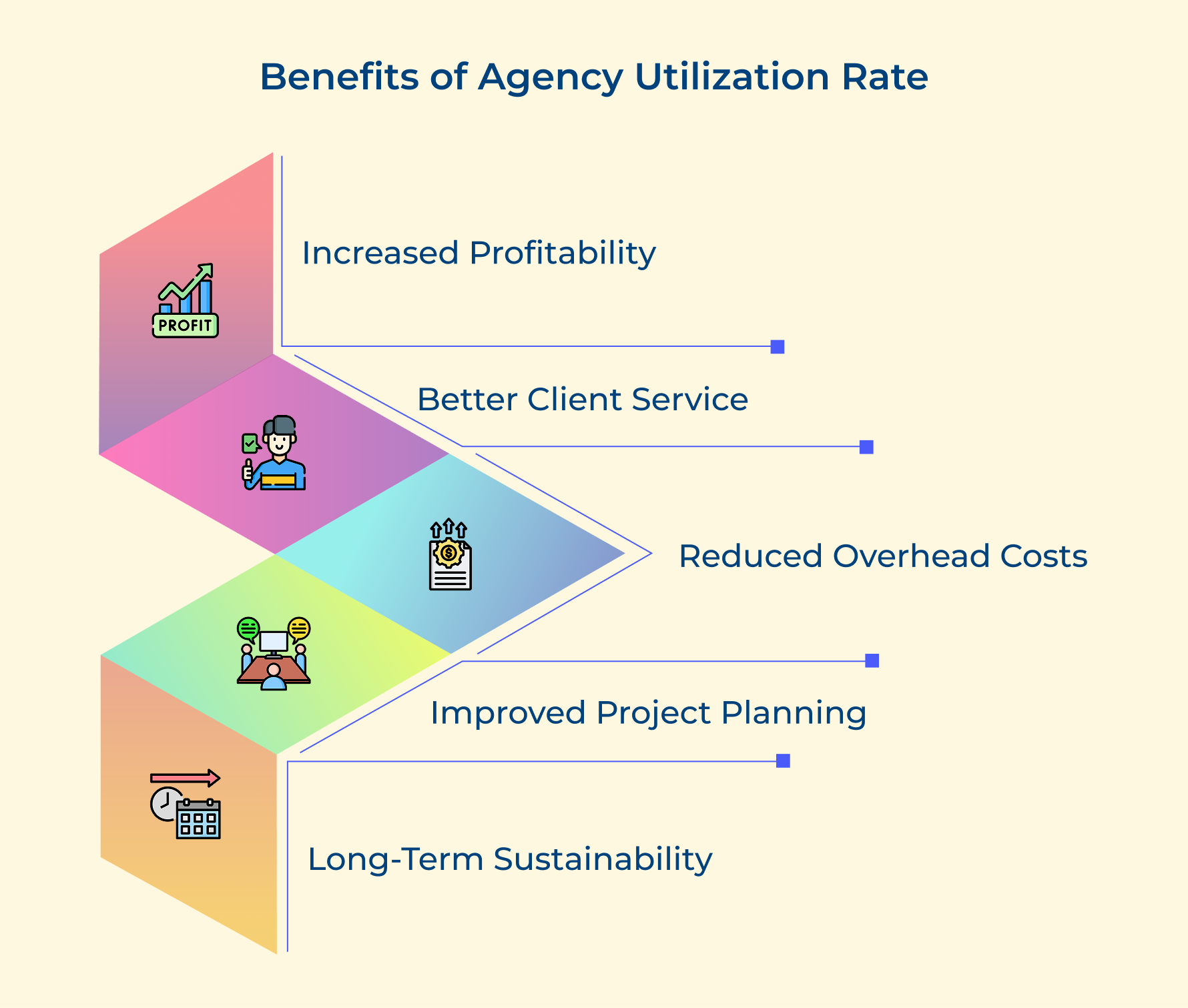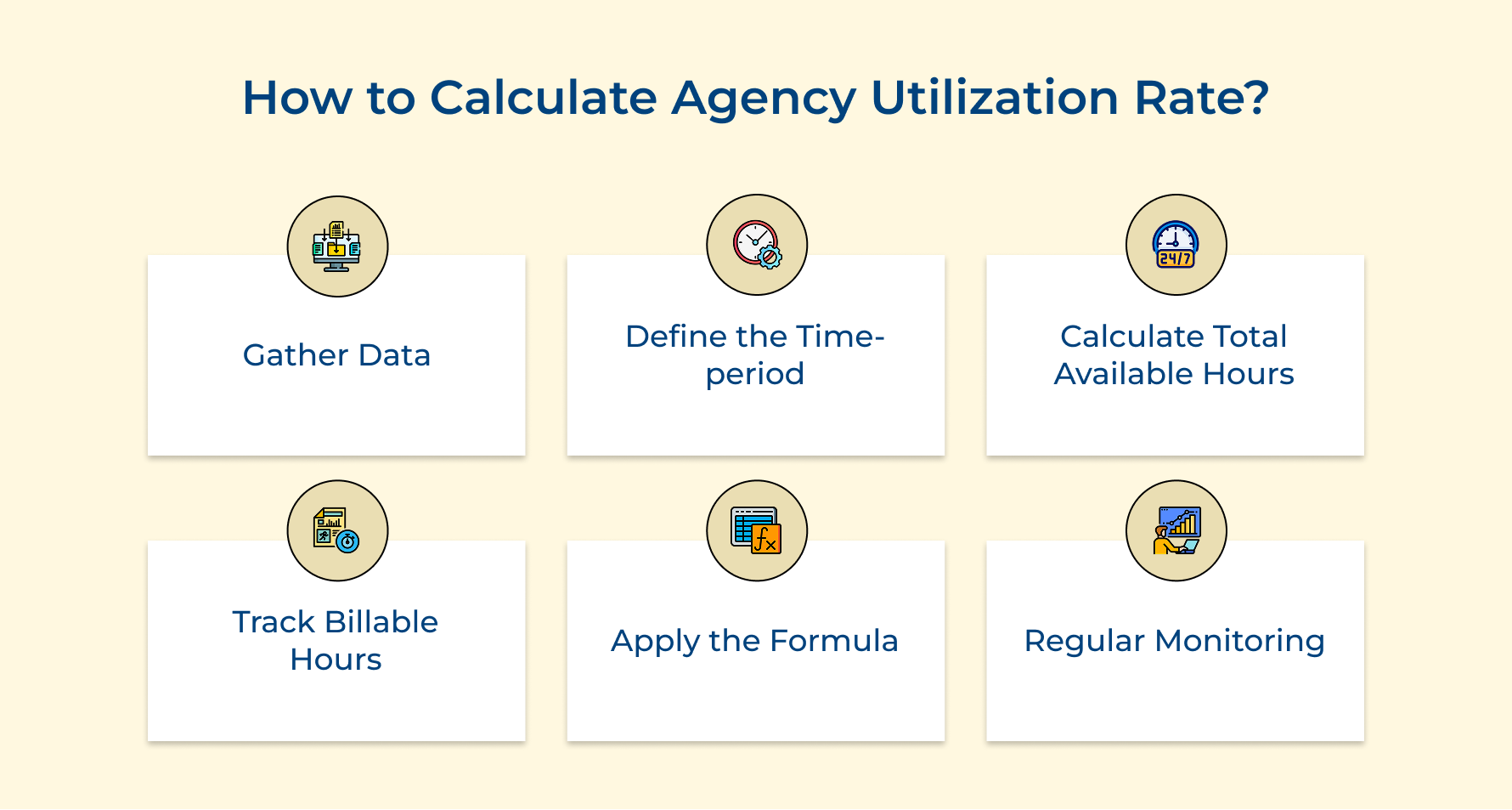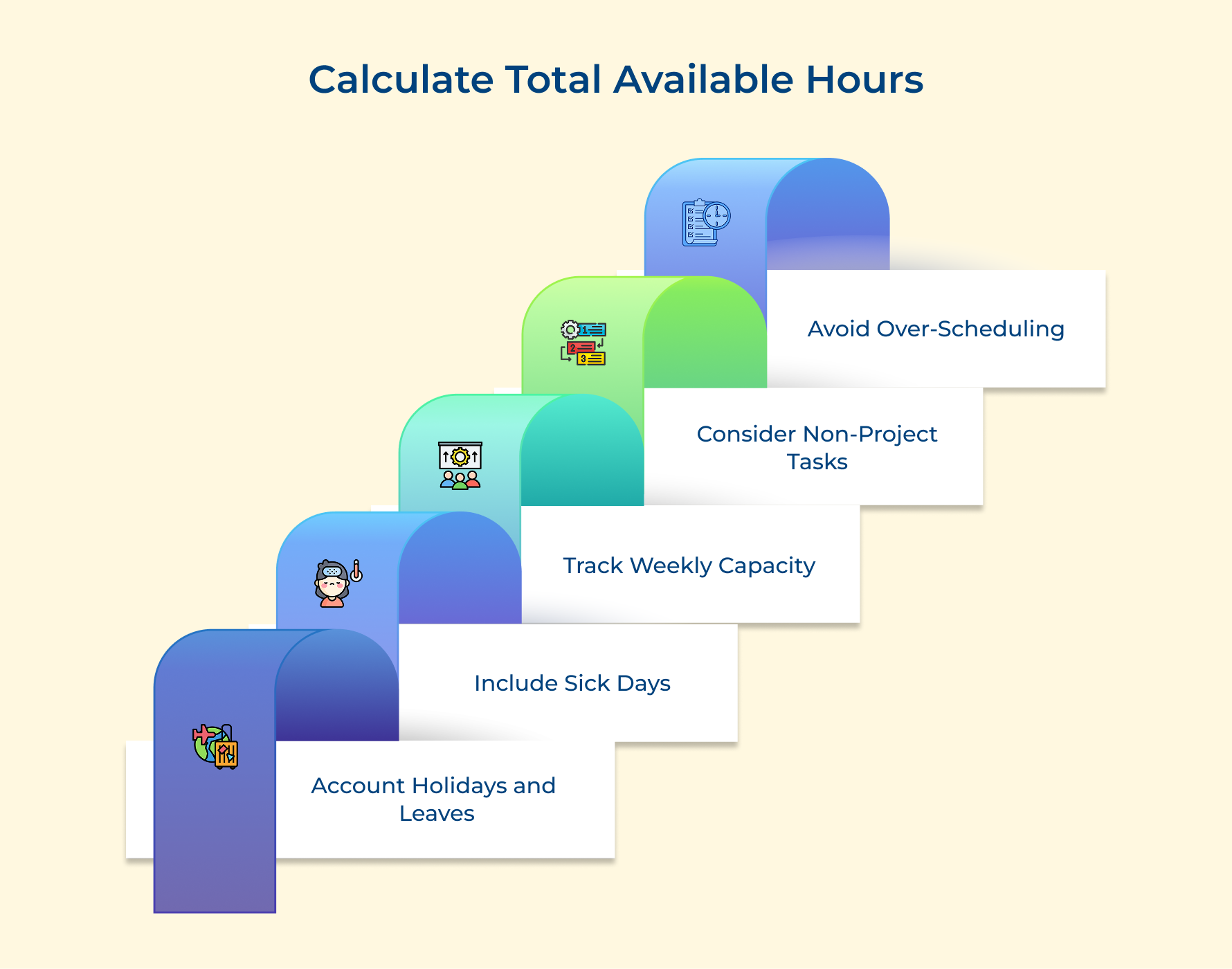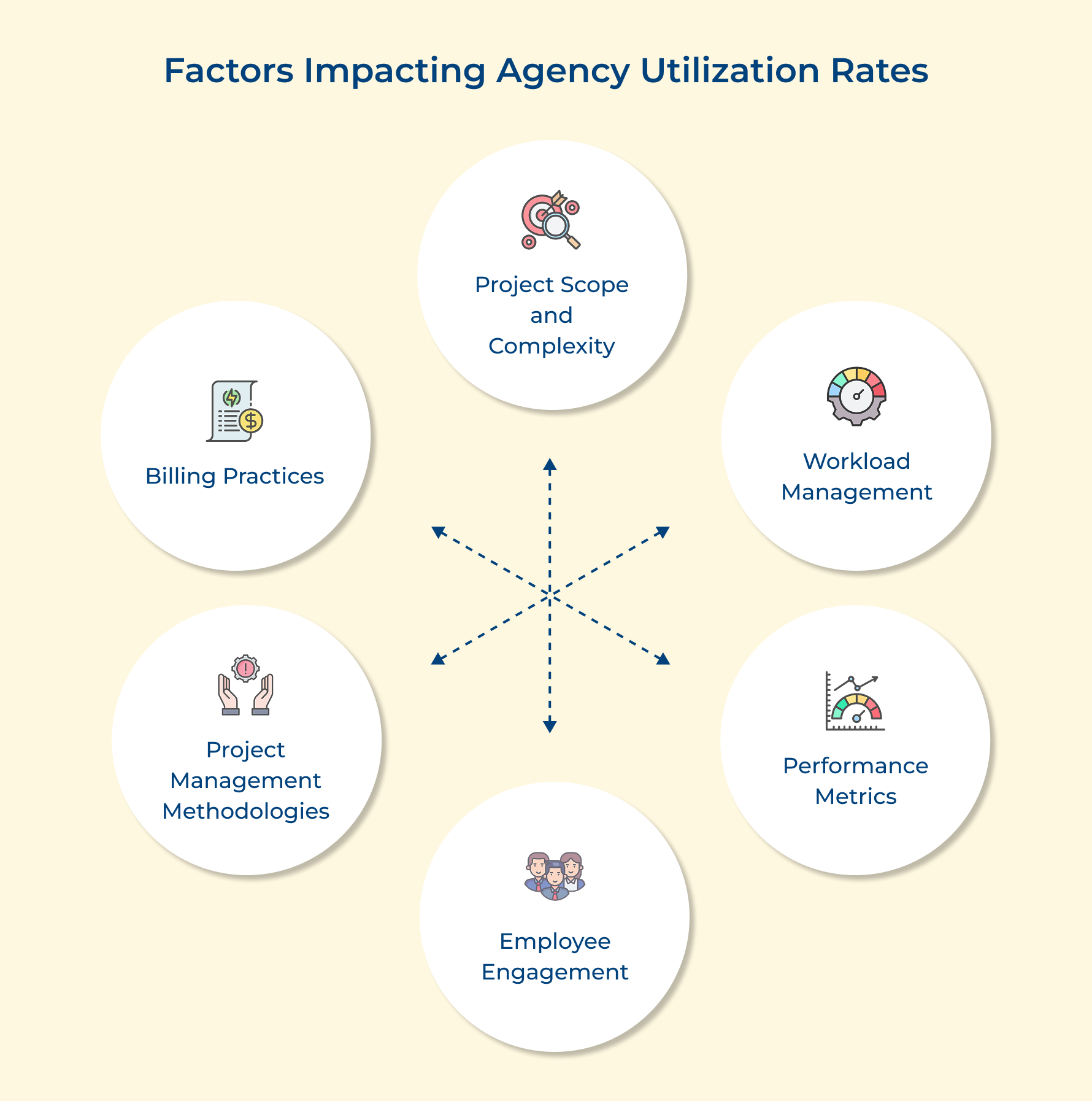Agency Utilization Rate: 6 Steps to Calculate it Accurately
- What is The Agency Utilization Rate?
- Key Benefits of Agency Utilization Rate
- How to Calculate Agency Utilization Rate: 6 Steps
- Tips for Optimizing Agency Utilization Rate
- Factors Impacting Agency Utilization Rates
- Challenges of Agency Utilization Rate
- Maximizing Agency Efficiency Through Utilization Insights
- FAQs about Agency Utilization Rate

Key Highlights:
- Agency utilization rate maximizes billable hours and revenue with effective resource utilization.
- Tailor utilization targets based on roles, workloads, and industry benchmarks.
- Boost productivity and utilization by building a positive along with a collaborative work environment.
Imagine an agency handling five client projects. Without tracking agency utilization rates, they assign tasks based on guesswork.
Team A ends up overworked, and missing deadlines, while Team B remains underutilized. The imbalance leads to burnout for some, wasted potential for others, and dissatisfied clients.
Now, let’s introduce utilization tracking. The agency identifies that Team A operates at 120% capacity, while Team B is only at 60%.
Redistributing workloads help balance resources effectively, ensure timely deliveries, and avoid burnout. This small shift enhances employee satisfaction and increases profitability, proving that tracking utilization rates is a game-changer for operations.
Let’s explore more about it!
What is The Agency Utilization Rate?
The agency utilization rate is a key metric that measures the efficiency of an agency’s workforce in terms of billable hours compared to total available hours.
It is calculated by dividing the total billable hours worked by employees by the total hours they are available to work, typically expressed as a percentage.
The metric provides valuable insights into how effectively an agency is utilizing its resources, particularly in service-based industries like marketing, advertising, and consulting.
Key objectives:
- Maximizing profitability: Ensuring that billable hours are optimized helps increase overall revenue and profitability for the agency.
- Enhancing resource management: Identifying underutilized resources enables better allocation of personnel, reducing costs and improving efficiency.
- Improving employee productivity: Tracking utilization rates can highlight trends in productivity, guiding efforts to boost team performance and engagement.
Key Benefits of Agency Utilization Rate
Understanding the benefits of agency utilization rates is essential for enhancing efficiency and profitability. Here are the key advantages.
Increased Profitability
Monitoring agency utilization rates directly correlates with increased profitability. Maximizing billable hours and ensuring effective resource deployment significantly boosts revenue. Improved utilization allows for taking on more projects without sacrificing quality.
Better Client Service
High utilization rates enhance client service by ensuring projects are completed on time and within budget. Effective resource management allows agencies to allocate the right team members to meet client needs, resulting in higher satisfaction and stronger relationships.
Reduced Overhead Costs
Optimal utilization rate helps agencies reduce overhead costs. Enhancing staff workloads minimizes the need for additional hires or external contractors, thereby lowering operational expenses. Improved efficiency not only enhances the bottom line but also strengthens overall financial health.
Improved Project Planning
Understanding utilization rates facilitates improved project planning. Accurate assessments of resource availability enable agencies to allocate team members based on skill sets and workloads. Strategic planning leads to more realistic timelines, clearer deliverables, and more successful project outcomes.
Long-term Sustainability
A well-utilized workforce ensures adaptability to market changes, maintains financial stability, and allows for investment in growth opportunities. Resilience in resource management positions agencies for continued success.
How to Calculate Agency Utilization Rate: 6 Steps
Calculating your agency’s utilization rate doesn’t have to be complicated. Follow these six simple steps to gain clarity on how effectively your team is using their time.
1. Gather Data
To calculate utilization rates effectively, you need solid data. Without clear insights into employee working hours, project time, and non-billable tasks, it’s impossible to make smart decisions about resource allocation, pricing, or efficiency.
Here’s how accurate data can help:
- Spot patterns: Understand how resources are allocated and identify peak productivity times.
- Fix inefficiencies: Pinpoint where workflows can improve and take action.
- Plan strategically: Make informed decisions about staffing, project timelines, and resource planning.
Choose one time-tracking system that automatically categorizes billable and non-billable hours. Make it user-friendly to minimize manual input. Create templates for tracking across departments.
2. Define the Time Period
Choosing a specific time period for tracking utilization rates adds clarity and consistency. It helps you analyze trends, set realistic goals, and account for seasonal variations or project cycles.
How does it make a difference?
- Spot trends: Compare utilization rates over time to uncover patterns or areas needing improvement.
- Adjust strategically: Use insights to fine-tune staffing, project schedules, and resource allocation based on business cycles.
Actionable Tips:
Stick to Regular Reporting Intervals
- Decide on weekly, monthly, or quarterly reviews.
- Consistent tracking makes trend analysis more reliable.
Plan for Seasonal Variations
- Map out a calendar of peak periods.
- Adjust your utilization targets to reflect busy or slow seasons.
3. Calculate Total Available Hours
Before diving into utilization rates, it’s important to know your team’s actual working capacity. It means factoring in holidays, vacations, sick leave, and other non-working periods to get a realistic baseline.
Without this, your calculations might set unrealistic expectations or misrepresent productivity.
Example:
If your agency has a team member with 40 hours a week but takes two vacation days, their actual working hours that week drop to 24. Planning their workload without considering this could lead to missed deadlines or overburdening other team members.
The calculation of these critical metrics helps you to,
- Plan better: Avoid over-scheduling and ensure adequate coverage during busy times.
- Stay realistic: Account for role-specific commitments like team meetings or admin tasks.
- Maintain balance: Prevent burnout while still meeting project goals.
4. Track Billable Hours
Tracking billable hours accurately is the backbone of understanding how your agency generates revenue. It shows which projects and clients take up the most resources, ensures proper billing, as well as uncovers areas where efficiency can improve.
How does it help, you ask?
- Spot high-value clients: Identify which clients bring in the most profit.
- Refine pricing: Use billable hour data to optimize project pricing strategies.
- Plan resources smarter: Allocate your team’s time more effectively based on patterns.
Actionable Tips:
Define Billable vs. Non-Billable Work
- Set clear guidelines on what counts as billable.
- Train your team to track time accurately.
Review Billable Hours Regularly
- Check hours weekly to catch unusual patterns or inefficiencies.
- Use insights to address potential issues before they escalate.
5. Apply the Formula
Let’s say Team A has a utilization rate of 75% while Team B shows 85%. Without a consistent formula, these numbers might not mean much.
But when calculated the same way, you can see that Team B is performing more efficiently—or maybe they’re overworked, requiring adjustments.
Using the same formula every time ensures your utilization rates are accurate and comparable across teams, departments, or periods.
The consistency makes it easier to spot trends, measure performance, and find areas to improve.
6. Regular Monitoring
Constantly monitoring your team’s utilization rates helps you catch trends, issues, and opportunities before they become bigger problems.
It lets you manage resources and workloads proactively, ensuring that your team is being used efficiently without risking burnout or sacrificing quality.
By staying on top of utilization data, you can make quick adjustments when needed and keep things running smoothly.
It keeps projects on track and prevents any unpleasant surprises down the road.
Tips for Optimizing Agency Utilization Rate
Optimizing your agency’s utilization rate is key to boosting efficiency and profitability. Here are some practical tips to help you make the most of your team’s time and resources!
Implement Time Tracking Tools
Invest in reliable time-tracking software that automatically captures billable and non-billable hours. Choose tools with user-friendly interfaces and mobile capabilities to ensure accurate tracking across all devices. Integration with project management and billing systems streamlines workflow as well as reduces administrative overhead.
Set Realistic Utilization Goals
Set attainable utilization targets based on role types, experience levels, and industry benchmarks. Consider factors like administrative responsibilities, team meetings, and professional development time when setting goals.
Regularly Review Utilization Rates
Schedule weekly or bi-weekly internal meetings for reviewing utilization data to identify trends and potential issues early. Compare rates across teams and projects to spot inefficiencies. Use these insights to make timely adjustments to workload distribution and resource allocation.
Conduct Performance Reviews
Hold regular performance discussions focusing on individual utilization patterns and challenges. Address any barriers to productivity as well as provide support where needed. Use these conversations to align personal development goals with optimal utilization targets and career growth.
Use Project Management Tools
Deploy comprehensive project management solutions that help track deadlines and monitor progress effectively. These tools should provide visibility into team capacity along with potential resource conflicts to maintain healthy utilization levels.
Provide Training for Efficiency
Invest in ongoing training programs that enhance team productivity and time management skills. Focus on teaching efficient work practices, essential tool usage, and effective prioritization techniques. Regular skill development helps improve overall team utilization rates.
Factors Impacting Agency Utilization Rates
Numerous factors influence agency utilization rates, affecting overall performance. Here are the critical elements that impact the average utilization rate.
Project Scope and Complexity
The size and complexity of a project directly impact how your team’s time as well as resources are utilized. Larger, more intricate projects often require careful planning and resource allocation.
Understanding the project’s scope ensures you assign the right manpower, allowing for smoother execution and on-time delivery without stretching your team too thin.
Workload Management
Balancing workloads is key to maintaining efficiency and avoiding burnout. When tasks are evenly distributed, team members stay engaged without feeling overwhelmed.
Regularly assessing workloads ensures everyone is contributing effectively, keeping your agency productive while maintaining a healthy work environment for your team.
Performance Metrics
Clear performance metrics are a must for tracking how well your team is utilizing their time. These benchmarks help identify areas for improvement and allow you to fine-tune processes.
Regularly reviewing these metrics ensures your team stays on track and aligned with your utilization goals.
Employee Engagement
Engaged employees are more productive and committed to their work. A positive work environment that promotes collaboration and values contributions boosts engagement levels.
When your team feels motivated and supported, they’re more likely to go the extra mile, directly improving utilization rates.
Project Management Methodologies
The way you manage projects plays a huge role in resource efficiency. Methodologies like Agile or Waterfall offer unique approaches to planning and execution.
Choosing the right one based on your project’s needs can streamline processes and ensure optimal utilization of your team’s time as well as skills.
Billing Practices
Transparent billing practices keep teams focused on maximizing billable hours without compromising quality.
Clear communication with clients about billing structures sets the right expectations. The alignment helps you manage resources effectively while ensuring both client satisfaction and agency profitability.
Challenges of Agency Utilization Rate
Navigating the challenges of agency utilization rates is crucial for success. Here are common obstacles agencies face and strategies to overcome them.
Accurate Measurement
Determining accurate utilization rates can be complex, especially distinguishing between billable and non-billable hours.
To improve measurement, implement robust time-tracking tools that categorize activities effectively. Regular audits of time entries can also ensure accuracy.
Changing Client Demands
Fluctuating client needs can disrupt resource allocation and impact utilization rates. To address this, maintain flexible staffing models that allow quick adjustments to project teams.
Consistent client check-ins help anticipate changes in demand, enabling proactive resource management to align with evolving project requirements.
Employee Engagement
Low employee engagement can lead to reduced utilization rates. To boost engagement, create a supportive work environment that recognizes contributions and promotes career development.
Timed feedback sessions and opportunities for skill enhancement create a motivated team, driving higher utilization through increased productivity.
Communication Issues
Poor communication can hinder effective utilization management and lead to misaligned expectations. Implementing regular team meetings and utilizing collaborative tools can enhance transparency as well as build open dialogue.
Clear communication about workloads, priorities, and availability helps ensure everyone is aligned effectively.
Maximizing Agency Efficiency Through Utilization Insights
The agency utilization rate functions as an important metric from a business and profitability perspective. Optimizing this rate allows agencies to maximize resource efficiency and improve profitability.
Regular tracking of utilization reveals areas for improvement, enabling adjustments to changing demands and enhancing workforce output. A strong focus on utilization leads to better project outcomes and increased client satisfaction, ultimately driving revenue growth. Integrating this metric into the overall business strategy ensures sustained competitive advantage and long-term financial success.
Limit time — not creativity
Everything you need for customer support, marketing & sales.
Neeti Singh is a passionate content writer at Kooper, where he transforms complex concepts into clear, engaging and actionable content. With a keen eye for detail and a love for technology, Tushar Joshi crafts blog posts, guides and articles that help readers navigate the fast-evolving world of software solutions.




